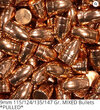Mountainman2
Member
Is it worth the time and expense of buying a separate die. I have been doing both at the same time On my 357 and 45 revolvers and T/C hand guns.
Last edited:
Is it worth the time and expense of buying a separate die.
As Atavar said, you don't need a separate die. For that matter, I don't even "remove" the seating stem when I crimp in a separate step - I just back the seating stem out a bit and screw the seating/crimping die IN until I get the desired amount of crimp.You don’t need a separate die, just remove the seating stem when crimping.
Q: if it works, why change?Is it worth the time and expense of buying a separate die. I have been doing both at the same time On my 357 and 45 revolvers and T/C hand guns.
Its pretty simple. As you seat and crimp at the same time you are pushing the bullet down at the same time you are bending in the case neck for the crimp. This means you are scraping into the bullet and leaving gouges as you crimp. Those gouges/troughs do not help accuracy. Using separate steps (no extra die needed) keeps the bullet as it was made -- nice and round with no trenches in it as a result of a crimp as it seats.

I have reloaded over 750,000 pistol rounds the past 30 years (I don't keep track of rifle rounds reloaded) and for taper crimping, simply returning case mouth flare back flat on bullet works fine to seat and taper crimp in one operation, even for lead/coated lead bullets.In my experience trying to set up a seating/crimping die to do both functions at the same time was unreliable at best and a waste of time at worst.
Dang man, I’ve seen this family picture so often I’m beginning to think they’re my kids not yoursIt’s obviously going to be bullet depended but the “crimp” I set my die’s (seat&crimp or seat then crimp) would often be better referred to as the bell/flare removal step.
Using either method, I pull bullets to ensure the crimp isn’t changing the bullets diameter as that destroys accuracy.
Why outfits sell bullets they have ruined vs loading them up in ammunition to sell (and ruin their reputation).
Like these.
View attachment 1165133
Well with all that loading when did you find time to learn how to be such a fine photographer? You and @Walkalong are expertsI have reloaded over 750,000 pistol rounds the past 30 years (I don't keep track of rifle rounds reloaded) and for taper crimping, simply returning case mouth flare back flat on bullet works fine to seat and taper crimp in one operation, even for lead/coated lead bullets.
I think some reloaders get into trouble of shaving lead/coated lead bullet or cutting into plated bullet maybe due to applying too much taper crimp and/or using too short of resized case to set the taper crimp amount and longer cases end up digging too much into the bullet.
I have been seating and taper crimping in same step for decades and jacketed/plated bullet won't give me much trouble. With lead/coated lead bullets, I am more careful with flare/taper crimp amount as too much resized case length variation can cause either not enough flare amount or too much taper crimp amount.
Below are .452" sized Lee tumble lubed 200 gr SWC and MBC 200 gr SWC seated and taper crimped in same step to .473" at case mouth (.452" + .011" + .011" = .473" with .011" being average case wall thickness at case mouth).

Below are .356" sized MBC 9mm lead/Hi-Tek coated bullets seated and taper crimped in same step to .378" at case neck (.356" + .011" + .011" = .378")


Of course, no issue seating and taper crimping in same step with jacketed/plated bullets (BTW, Speer TMJ is thick plated bullet and Zero 9mm bullet is sized larger at .356"). .355" sized bullets were taper crimped to .377" (.355" + .011" + .011" = .377") and .3555"/.356" sized bullets were taper crimped to .378" - https://www.thehighroad.org/index.p...s-and-discussions.778197/page-9#post-10648145


And returning flare back flat on bullet maintains square case mouth to "headspace" with forward part of chamber as shown below RMR 9mm 124 gr FMJ sized .3555" with .378" taper crimp loaded to 1.130". Note the sharp 90 degree edge of case mouth to headspace with the chamber (And note the even case neck bulge around the bullet base to indicate good neck tension and that bullet was not tilted during seating which would produce one sided bulge) - https://www.thehighroad.org/index.p...-and-discussions.778197/page-10#post-11419509
So yes, you can seat and taper crimp in one step.

